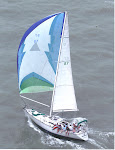From Pensacola to Mobile Bay was only a short run and as the weather was nice we proceeded offshore motoring as usual.
Along the way we saw our first rigs. These stretch all the way to Tampico, Mexico in a great arc of oil producing formations.
The passage into Mobile Bay was surprisingly rough as current opposed wind and waves. The wind was only 12 to 15 knots so I wonder what conditions would have been like in a blow. We were guided into the bay by an historic old lighthouse on Sand Island. This lighthouse is decommissioned and endangered by erosion. Likely it will be washed away entirely eventually.
Our destination was Dauphin Island, Alabama. We wanted to stop to compare it to our favorite beach town--Port Aransas, Texas. However, there was no safe way to get into the marina our 5 and 1/2 foot draft. So we anchored on the north side of the island in 10 feet of water about a half mile offshore.
The next day brought more fair weather and White Pepper was actually able to sail for several hours. Mississippi Sound is delightful in the prevailing winds that we experienced that day. It does have a long fetch between the mainland and the barrier islands. I suspect that it would be rough in brisk norther. We saw the first of the commercial barges that clog the Gulf Intracoastal Waterway between Mobile and Brownsville.
The next anchorage was Cat Island, a barrier island just south of Gulfport, Mississippi. We anchored again in 10 feet of water about a half mile offshore. We did not go ashore and spent a pleasant night at anchor.
Cat Island, MS
Our last day on Mississippi Sound was a short trip across Lake Borgne to Rabbit Island. Rabbit Island is the only practical anchorage in this part of the world. It is part of the Rigolets (pronounced Rigly by the locals). The Rigolets are a systems of sand berms and channels that form the entrance to Lake Pontchartrain. From here our plan was the motor 20 miles into New Orleans and cross the Mississippi River. The disaster that was the next day will be the subject of our next post.






No comments:
Post a Comment